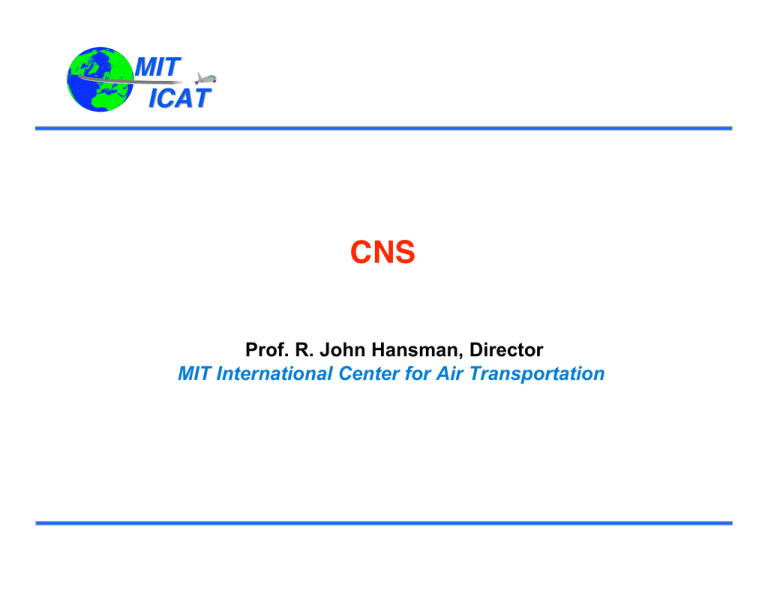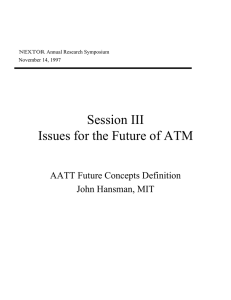CNS MIT ICAT Prof. R. John Hansman, Director
advertisement

MIT ICAT CNS Prof. R. John Hansman, Director MIT International Center for Air Transportation MIT ICAT • Airports • Runways Terminals Ground transport interface Servicing Maintenance Air traffic management • COMPONENTS OF AIR TRANSPORTATION INFRASTRUCTURE Communications Navigation Surveillance Control Weather Observation Forecasting Dissemination • Skilled personnel • Cost recovery MIT ICAT MIT ICAT MIT ICAT Timing Techniques • Problem with calibrating power • Time of flight Tor = 2Rc + transponder relay time R • Multi-lateration GDOP, HDOP, VDOP MIT ICAT Weather Radar MIT ICAT COMMUNICATION TRENDS • Voice VHF (line of sight), 25khz, spacing US, 8.33 khz Europe HF (over the horizon) Ground lines • Datalink (line of sight) ACARS (VHF) VHF Data Link (VDL) Modes 2 (31.5kbps), Mode 4 CPDLC • Aeronautical Telecommunications Network (ATN) CDMA, TDMA TCP/IP MIT ICAT • COMMUNICATION TRENDS Satellite Geosynchronous (data, voice, images) • Air-ground • Ground-ground LEO and MEO Networks • (XM & Sirius Data Downlinks (WX) • Groundlines Switches MIT ICAT Communication Trend Datalink Standardization Challenge • Expanded ACARS use (PDC, Oceanic Clearances, Taxi) • FANS 1 / FANS A A • VDL Mode 2 (Petal) (Petal) • ATN ATN • VDL Mode 3? 3? • VDL Mode 4? 4? Source: Tom Imrich, Boeing http://nas-architecture.faa.gov/nas/mechanism/mech_data.cfm?mid=100021 MIT ICAT NAS Architecture Elements Communication 1 Aeronautical Telecommunication Network Air to Ground Router (ATN A/G Router) (ATN A/G Router Data Communication (Data Communication... Aeronautical Data Link (ADL) - Enhanced (ADL-E Aeronautical Data Link Decision Support System Services (ADL DSSS Aeronautical Data Link National Deployment (ADL National Deployment Alaskan NAS Interfacility Communications System Phase II (ANICS Phase II Commercial Weather Vendor (CWV Communications Management System (CMS Controller-Pilot Data Link Communications Build I (CPDLC Bld I Controller-Pilot Data Link Communications Build IA (CPDLC Bld IA Controller-Pilot Data Link Communications National Deployment (CPDLC National Deployment FAA Telecommunications Satellite (FAATSAT Flight Information Service - Data Link (FISDL High Frequency Data Link (HF Data Link Multi-Sector Oceanic Data Link (MSODL NGATS Data Communications (NGATS Data Comm NOTAM Distribution Program (NDP Satellite Telecommunications Data Link (SATCOM DL System Wide Information Management (SWIM System Wide Information Management Spiral 1 (SWIM Spiral 1 System Wide Information Management Spiral 2 (SWIM Spiral 2 System Wide Information Management Spiral 3 (SWIM Spiral 3 Terminal Weather Information for Pilots (TWIP Tower Data Link System Refresh (TDLS Refresh Video Communication (Video Communication...) http://nas-architecture.faa.gov/nas/mechanism/mech_data.cfm?mid=100021 MIT ICAT NAS Architecture Elements Communication 2 (voice) Voice Communication (Voice Communication... Air/Ground Communications RFI Elimination (RFI ELIM Backup Emergency Communications (BUEC Command and Control Communications (C3 Conference Control System (CCS Digital Voice Recorder System (DVRS/DVR2 Digital Voice Recorder System Replacement (DVRS Repl Emergency Transceiver Replacement (ETR Emergency Voice Communications System (EVCS Enhanced Terminal Voice Switch (ETVS Future Communications Infrastructure - Phase 1 (FCI-P1 Future Radio System - Phase 1 (FRS-P1 High Frequency Communications (HF Communications Integrated Communications Switching System Type I (ICSS I Multi-Channel Recording System (MCR Multi-Mode Digital Radios (MDR NAS Voice Switch (NVS Radio Control Equipment Sustainment (RCE Sustain Rapid Deployment Voice Switch Type I (RDVS I Satellite Communications (SATCOM Small Tower Voice Switch (STVS Ultra High Frequency Ground Radios (UHF Ground Radios Ultra High Frequency Ground Radios - Replacement (UHF Ground Radios - Relp Very High Frequency Ground Radios (VHF Ground Radios Very High Frequency/Ultra High Frequency Emergency Communications Transceivers - Terminal (V Voice Switching and Control System (VSCS Voice Switching and Control System Training and Backup Switches (VTABS) http://nas-architecture.faa.gov/nas/mechanism/mech_data.cfm?mid=100021 MIT ICAT NAS Architecture Elements Communication 3 (WAN) WAN Communication (WAN Communication... Aeronautical Telecommunication Network Ground to Ground Router (ATN G/G Router Agency Data Telecommunications Network 2000 (ADTN2000 Alaskan National Airspace System Interfacility Communications System (ANICS Alaskan National Airspace System Interfacility Communications System Phase II (ANICS Phase II Bandwidth Manager (BWM Data Multiplexing Network (DMN En Route Communications Gateway (ECG En Route Communications Gateway Technology Refresh (ECG Tech Refresh FAA Bulk Weather Telecommunications Gateway (FBWTG FAA Telecommunications Infrastructure (FTI Federal Aviation Administration Telecommunications Satellite (FAATSAT Federal Telecommunications System 2001 (FTS 2001 High Frequency Aeronautical Telecommuniction Network Data Link (HF ATN DL Interfacility Communications (Interfacility Comm Leased Inter-facility National Airspace System Communication System (LINCS Low-Density Radio Communications Link (LDRCL National Airspace Data Interchange Network Message-Switched Network (NADIN MSN National Airspace Data Interchange Network Packet-Switched Network (NADIN PSN Next Generation Messaging (NEXGEN Messaging Radio Communication Link (RCL Radio Control Equipment (RCE System Wide Information Management (SWIM Weather Message Switching Center Replacement (WMSCR Weather Message Switching Center Replacement (WMSCR) Sustain (WMSCR Sustain) MIT ICAT Federal Telecom Infrastructure (FTI National Aviation Data Integration Networ (NADIN) MIT ICAT NAVIGATION TRENDS (ENROUTE) • Radionavigation beacon VHF Omnidirectional Range (VOR) Non-Directional Beacon (NDB) Distance Measuring Equipment (DME) TACAN • Aero navigation systems (ground based) Omega LORAN • Inertial navigation systems • Satellite navigation systems GPS (CA) Glonass GNSS MIT ICAT NAVIGATION TRENDS (ENROUTE) • Radionavigation beacon VHF Omnidirectional Range (VOR) Non-Directional Beacon (NDB) Distance Measuring Equipment (DME) TACAN • Aero navigation systems (ground based) Omega LORAN • Inertial navigation systems • Satellite navigation systems GPS (CA) Glonass GNSS MIT ICAT LORAN • Master Slave Architecture • Low Frequencey (100khz) Center Freq • Hyperbolic Coordinates • Geometric Dilution of Precision MIT ICAT GPS Frequencies * L1 (1575.42 MHz): Carries a publicly usable coarse-acquisition (C/A) code as well as an encrypted precision P(Y) code. * L2 (1227.60 MHz): Usually carries only the P(Y) code, but will also carry a second C/A code on the Block III-R satellites. * L3 (1381.05 MHz): • Carries the signal for the GPS constellation's alternative role of detecting missile/rocket launches (supplementing Defense Support Program satellites), nuclear detonations, and other high-energy infrared events. • * L4 (1841.40 MHz): • Being studied for additional ionospheric correction. * L5 (1176.45 MHz): Proposed for use as a civilian safety-of-life (SoL) signal. This frequency falls into an internationally protected range for aeronautical navigation, promising little or no interference under all circumstances. The first Block IIF satellite that would provide this signal is set to be launched in 2008. http://en.wikipedia.org/wiki/GPS MIT ICAT GPS ISSUES • Requirements Accuracy Integrity Availability • Selective Availability (SA) Degraded to 100m accuracy • Control by US DoD International concerns • US guarantee of service free to world through 2005 • Vulnerability to jamming • DGPS WAAS EGNOS LAAS MIT ICAT NAVIGATION TRENDS (APPROACH) • Instrument Landing System (ILS) Cat. I (200 ft; 1/4 mile) Cat. II (50 ft; 800 RVR) Cat. III (0,0) • Microwave Landing System (MLS) • GPS (100m) Wide Areas Augmentation System (5m) • Cat. I, Cat. II Local Areas Augmentation System (0.1m) • Cat. III • Change to Required Navigation Performance (RNP) MIT ICAT GPS Approach Navigation • Requirements Accuracy (RNP) Availability Integrity • Differential GPS SBAS Sattelite Base Augmentation Systems • Wide Area Augmentation System (WAAS) Non-Precision Approaches (GPS Overlay) RNAV Approachet LPV Approaches (250 ft, 1/4 mile) Ground Based Augmentation Systems • Local Area Augmentation System (LAAS) GLS (Cat II+) RNAV and RNP: Key Building Blocks of Performancebased Navigation MIT ICAT RNAV • Point-to-point routes • Radar monitoring • 90+% capable fleet Increased Airspace Efficiency RNP Containment Seamless Vertical Path • More complex routes • Tighter performance • No radar requirement“curved” • 30+% capable fleet paths Optimized Use of Airspace Performance-Based NAS Approaches MIT ICAT RNP-x (SAAAR) xLS Default (Notional figure) MIT ICAT WAAS Fielding Status Auburn (ZSE) Billings (BIL) GPS Satellite Communication Satellite Farmington (ZMP) Brewster GES Oberlin (ZOB) Fremont (ZOA) Santa Paula GES (2) Palmdale (ZLA) Anchorage (ZAN) Salt Lake City (ZLC) Longmont (ZDV) Albuguerque (ZAB) Juneau (JNU) Cold Bay (CDB) Ronkonkoma (ZNY) Clarksburg GES Aurora (ZAU) Leesburg (ZDC) Olathe (ZKC) Fort Worth (ZFW) Nashua (ZBW) Hampton (ZTL) Houston (ZHU) Memphis (ZME) Jacksonville (ZJX) Miami (ZJX) Honolulu (HNL) San Juan (ZSU) Figure by MIT OCW. Phase 1 WRS Phase 1 WMS/WRS Phase 1 GES WMS = Wide-area Master Station WRS = Wide-area Reference Station GES = Ground Earth Station MIT ICAT Safety Architecture Receiver Corrections Processor Safety Processor Uplink/GEO User Satellite Signals Generates data (Level D) • CRC protects data Weaknesses in Current System Monitor (Safety Processor) • Monitors data (Level B) At Times Safety Processor Doesn’t Monitor Data Therefore, System Integrity Is Not Quantifiable Integrity Requirement Is No More Than One in 10 Million Chance of Hazardously Misleading Information (10-7) GBAS Ground Based Augmentation System MIT ICAT GPS SV GPS SV GPS SV GEO SV MMR GPS Rx GPS Rx VDB Tx GPS Rx GPS Rx Figure by MIT OCW. US Local Area Augmentation System (LAAS) GBAS Ground Station MIT ICAT GLS - System Concept • GPS based • GBAS (e.g., LAAS) • VHF Data Link • MMR (ILS, GLS,) VHF DATALINK • Uplinked WPs • Multiple Paths • Future Satellites GBAS Corrections & final approch Segment Data MMR Multi Mode Reciver GLS (3rd Gen GPS; Galileo; Glonass) Figure by MIT OCW. Ground Based Augmentation System MIT GLS - Primary Flight Display ICAT • Path Indications - Common • Autoflight Status - Common • Mode Annunciation - Common • NAV Source Clearly Shown (ILS; GLS; FMS; ID; WP Distance) MIT ICAT 2005 GLS(200) Potential GNSS Services 2015 2025 GPS & Galileo OS dual-frequency & IRU GPS & SBAS & Galileo OS dual frequency GPS & SBAS dual frequency (& Galileo OS) GPS & GBAS (where necessary) LPV GPS & SBAS GPS & Galileo SOL dual-frequency RNP-0.1 GPS & IRU GPS & SBAS GPS & Galileo OS dual-frequency GPS dual-frequency Sourc: Bruce Declean (FAA) MIT ICAT Source: Brian Kelly, Boeing Navigation & Communication MIT ICAT SURVEILLANCE TRENDS • Primary radar Enroute (12 sec scan) Terminal area (4.2 sec scan) • Secondary radar Transponders • Mode C (altitude) • Mode S (2-way data exchange) • Onboard surveillance TCAS • Automatic Dependent Surveillance (ADS) Oceanic (INS Based) GPS squitter (Mode S) ATC Control Loop Radar Surveillance Limits MIT ICAT F lig ht S trip s Decision Aids ATC Displays Flight Plan Amendments Surveillance: Enroute: 12.0 s Terminal: 4.2 s ADS : 1s Vectors Voice AOC: Airline Operations Center Pilot ACARS (Datalink) CDU MCP Tra je cto r C omm ands Initial Clearances Controls S tate C omm ands F lig ht M anagem ent C om p ute r Displays Manual Control Autop ilo t Auto thrust Aircraft S tate N av ig atio n Emerging Approaches: ADS-B and Multi-Lateration MIT ICAT CO 123 350C B757 310 Radar Display Example MIT ICAT Enroute Display MIT ICAT Enroute Display 1. Uncorrelated primary radar target [o] [+] 2. Correlated primary radar target *See note below. 3. Uncorrelated beacon target [ / ] 4. Correlated beacon target [ \ ] 5. Identing beacon target *Note: in Number 2 correlated means the association of radar data with the computer projected track of an identified aircraft. Position symbols: 6. Free track (no flight plan tracking) 7. Flat track (flight plan tracking) 8. Coast (beacon target lost) [#] 9. Present position hold Data block information: 10. Aircraft ident *See note below. 11. Assigned altitude FL 280, Mode C altitude same or within 200' of assigned altitude. *See note below. 12. Computer ID #191, handoff is to sector 33 (0-33 would mean handoff accepted) *See note below. 13. Assigned altitude 17,000', aircraft is climbing, Mode C readout was 14,300 when last beacon interrogation was received. 14. Leader line connecting target symbol and data block. 15. Track velocity and direction vector line (projected ahead of target) 16. Assigned altitude 7,000, aircraft is descending, last Mode C readout (or last reported altitude) was 100' above FL 230 17. Transponder code shows in full data block only when different than assigned code 18. Aircraft is 300' above assigned altitude 19. Reported altitude (no Mode C readout) same as assigned. (An "n" would indicate no reported altitude.) MIT ICAT Enroute Display 20. Transponder set on emergency Code 7700 (EMRG flashes to attract attention) 21. Transponder Code 1200 (VFR) with no Mode C 22. Code 1200 (VFR) with Mode C and last altitude readout 23. Transponder set on radio failure Code 7600 (RDOF flashes) 24. Computer ID #228, CST indicates target is in coast status 25. Assigned altitude FL 290, transponder code (these two items constitute a "limited data block") *Note: numbers 10, 11, and 12 constitute a "full data block" Other symbols: 26. Navigational aid 27. Airway or jet route 28. Outline of weather returns based on primary radar. ” H" represents areas of high density precipitation which might be thunderstorms. Radial lines indicated lower density precipitation. 29. Obstruction 30. Airports MIT ICAT ASR-11 Sites MIT ICAT ARTS III Terminal Display 1. Areas of precipitation (can be reduced by CP) 2. Arrival/departure tabular list 3. Trackball (control) position symbol (A) 4. Airway (lines are sometimes deleted in part) 5. Radar limit line for control 6. Obstruction (video map) 7. Primary radar returns of obstacles or terrain (can be removed by MTI) 8. Satellite airports 9. Runway centerlines (marks and spaces indicate miles) 10. Primary airport with parallel runways 11. Approach gates 12. Tracked target (primary and beacon target) 13. Control position symbol 14. Untracked target select code (monitored) with Mode C readout of 5,000' 15. Untracked target without Mode C 16. Primary target 17. Beacon target only (secondary radar) (transponder) 18. Primary and beacon target 19. Leader line 20. Altitude Mode C readout is 6,000' 21. Ground speed readout is 240 knots 22. Aircraft ID 23. Asterisk indicates a controller entry in Mode C block. In this case 5,000' is entered and "05" would alternate with Mode C readout. 24. Indicates heavy 25. "Low ALT" flashes to indicate when an aircraft's predicted descent places the aircraft in an unsafe proximity to terrain. (Note: this feature does not function if the aircraft is not squawking Mode C. MIT ICAT ARTS III Terminal Display 26. NAVAID's 27. Airways 28. Primary target only 29. Nonmonitored. No Mode C (an asterisk would indicate nonmonitored with Mode C) 30. Beacon target only (secondary radar based on aircraft transponder) 31. Tracked target (primary and beacon target) control position A 32. Aircraft is squawking emergency code 7700 and is nonmonitored, untracked, Mode C 33. Controller assigned runway 36 right alternates with Mode C readout (Note: a three letter identifier could also indicate the arrival is at specific airport) 34. Ident flashes 35. Identing target blossoms 36. Untracked target identing on a selected code 37. Range marks (10 and 15 miles) (can be changed/offset) 38. Aircraft controlled by center 39. Targets in suspend status 40. Coast/suspend list (aircraft holding, temporary loss of beacon/target, etc.) 41. Radio failure (emergency information) 42. Select beacon codes (being monitored) 43. General information (ATIS, runway, approach in use) 44. Altimeter setting 45. Time MIT ICAT ADS-B Simplified System (No MFD) GPS antenna UAT Data Link Unit UAT Top and Bottom Antennas Discrete Panel GPS RX UAT Data Link and Processor Power Supply Altitude Encoder Input DC Power In MIT ICAT Traffic Symbology Bill Kaliardos (FAA) Figure 1 Basic Traffic Symbol Set MIT ICAT Maintenance Costs (1995 Dollar Estimates) • HF Voice $5,000 • NDB $30,000 • VOR $200,000 • DVOR/DME $450,000 • ILS Cat 1 $500,000 • ILS Cat II $550,000 • Primary Radar $6 million • SSR $2 million Source: ICAO FANS Investment Plan for India MIT ICAT • Surface observations Human Assisted Automated (ASOS, AWS) • WX radar • Satellite observations VIS IR Soundings • Pilot observations PIREPs (voice) ACARs downlink • Winds, temperature WEATHER TRENDS • Forecasts Model based (ETA 20km grid) Terminal • WX communications trend Teletype Fax WWW Ground-air uplink FAA Dept of Commerce (NOAA) Commercial Venders MIT ICAT Weather Information Distribution Examples • http://adds.aviationweather.noaa.gov/ • http://www.aopa.org/members/wx/? • http://www.duats.com/ • http://www.wsi.com/aviation/solutions/



